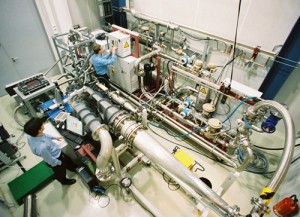
Automakers and suppliers have plowed more money than ever into research and development, but didn't get a great rate of return.
While the auto industry’s investment in research and development has soared in recent years, it generates less profit than it did 10 years ago, according to a new study by Alix Partners.
“The productivity and investment-efficiency improvements that automakers expected from their massive vehicle-platform and modules-based product development don’t seem to have materialized,” the summary of the report noted.
“Instead, they appear to have been offset by the increased complexity of all the new high technology brought into cars and trucks in recent years,” the report noted.
“Our analysis shows that the number of vehicles built off architectures with an average scale of more than 1 million units per platform – what some call ‘mega-platforms’ – has more than doubled in the last decade, which, in turn, should have facilitated savings in the range of 6% on recurring products costs and about 15% on nonrecurring costs. But that simply doesn’t appear to have happened.”
The Alix report also said suppliers are faring only marginally better than carmakers in this arena. The automotive industry has had a busy decade as it faced complex challenges from a wave of new models and technologies while needed to meet regulatory requirements for safety and emissions, it noted.
“The auto industry’s first priority should be to gain more control over the heart of high technology and whether technology truly delivers savings of not such as software development,” it added.
Companies such as General Motors and Ford Motor Co. have tried to meet the challenge by hiring hundreds of engineers and software developers to focus on future products.
(Trump Administration review autonomous car rules. Click Here for the story.)
Alix also said the industry has tried to cope with challenges using global vehicle platforms and other strategies. Companies bundled R&D efforts across multiple brands and models by way of increased standardization and modularization, for example.
They introduced new architecture that spanned multiple body styles and price segments, that shared the same technical basis, and that used a standard kit of interchangeable modules that met local customer requirements for cost and performance.
Since 2007, the automotive industry’s growth has come entirely from vehicles built of these platforms, and that trend is expected to continue in the coming years. In 2007, 17 million vehicles were built on platforms with an average scale of more than 1 million units per platform.
In 2016, that number more than doubled to 37 million vehicles, and the forecast for 2020 is more than 50 million vehicles, representing more than half of global vehicle production volumes.
“Looking ahead to the next decade, research and development challenges do not appear to diminish. A sharper focus on closer-to-end product development and the integration of new technology and features will increasingly become key market differentiators for OEMs.
“Most innovations across vehicle functions will come from electronics suppliers and will involve extensive software and mechatronics integration. This is particularly true for four major trends that are affecting the industry,” the report said.
Connectivity, with 70% global market penetration, through both tethered device integration and embedded technologies, is expected to provide a full value-added services offering by 2021.
(Click Here for more about Mexico warning Trump about tariff talk.)
Fast-paced adoption of advanced driver assistance systems, with 40% of new vehicle coverage by 2020, will progressively extend to fully autonomous driving. OEMs are increasingly having to interact with new software-savvy players as the new shared mobility business models gain traction.
Mass-market adoption of electrification is expected beyond 2020 because battery technology and its industrialization will push costs below the threshold of $200 per kilowatt-hour — to begin to be competitive with internal combustion engines.
The increasing electrification and dominance of software coupled with what’s perceived as a weak response by traditional OEMs have encouraged technology companies to enter the market with their own offerings. This directly challenges the traditional integrator role of OEMs.
The Alix report also said, “Our analysis shows that the doubling of vehicle platform volumes facilitates potential savings in the range of 6% on recurring product costs and about 15% on nonrecurring costs, 10% of which approximately relates to vehicle and power rain engineering.
Research and development spending as a percentage of sales has increased, but the return on the investment has declined. To offset the negative impact, manufacturers seem to have significantly addressed gross margins through product cost reduction and net sales optimization and streamlining selling, general and administrative expenses.
(More worries as Tesla strains finances to launch Model 3. Find out more, Click Here.)
Automotive suppliers appear to have fared somewhat better than OEMs, though significant differences seem to exist across commodities: interior suppliers improved the most; electronic ones deteriorated the most.

